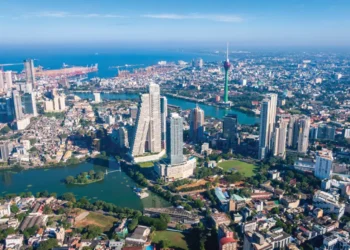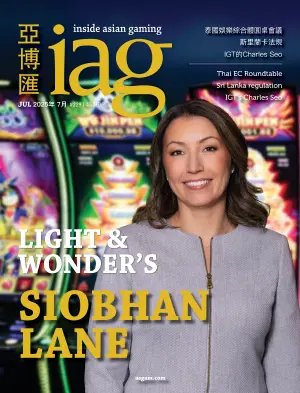Caesars Palace, opened in 1966, was for many years renowned as a mecca for boxing fans due to hosting so many of the world’s biggest bouts. With time, however, the famous property has moved toward other forms of entertainment such as musical acts and a wide variety of food and beverage options. IAG speaks with Caesars Entertainment’s President of Entertainment, Jason Gastwirth, about Caesars’ philosophy on providing a quality and diversified entertainment experience.
The Colosseum at Caesars Palace was built to coincide with Celine Dion’s “A New Day” residency in Las Vegas, which opened in 2003. Billboard described it as the best live concert venue of the past decade.

Now 16 years old, major renovations were announced in April of this year. Once complete, the updated venue will introduce the first and only automatic seat lifting system in Las Vegas for VIP tables with bottle service as well as main floor seats, on top of a state-of-the-art sound system, mobile lighting equipment and a high-resolution LED video wall. The new seating system will allow the floorplan to be changed depending on the performance.
Caesars Entertainment has also acquired the operating rights for the Colosseum and signed a contract for a joint promotion with leading promotion firm Live Nation. Among the first artists to perform at the venue once it re-opens this fall will be the likes of singer Rod Stewart, comedian Jerry Seinfeld and the “Queen of Pop” – Madonna.
IAG: Why is quality entertainment so important to the success of a company like Caesars?
Jason Gastwirth: When Caesars Entertainment built The Colosseum at Caesars Palace in Las Vegas in 2003 for Celine Dion’s residency performances, we unknowingly sparked the hottest trend in live shows that the IR entertainment landscape would ever see. Until then, it was unheard of for a superstar to plant herself at a single venue for a prolonged “residency,” but we experienced monumental success.
Caesars Palace hosted over 1,000 shows over 16 years with Celine Dion to great success. This also led to performances by Elton John, Britney Spears, Backstreet Boys and Jennifer Lopez. The iconic and award-winning theater was also an ideal venue for regular performances by Christina Aguilera, Gwen Stephanie, Mariah Carey and Sting.
IAG: How would you describe the Caesars approach to entertainment?
JG: We place our focus on quality and diversity. From the superstar resident headliners in our larger venues down to our smaller showrooms, my team works diligently to ensure our guests enjoy the finest entertainment from a diverse and dynamic roster of incredible talent.

IAG: What is the key to catering to such a broad range of customers, both culturally and across the age spectrum?
JG: Quality. Whether the show is energetic, emotional, romantic, traditional, raucous or hilarious, we focus on the production meeting the standard of quality and excellence Caesars Entertainment is so widely known for by our guests. No matter how the show appeals to age or origin, we start with ensuring we are partnering in a quality product.
IAG: What do you see coming in the future? Especially with regard to IRs. What do you think will be popular?
JG: The popularity of the residency model is so big now that I don’t think we can even call it a trend any longer, but it is definitely where we focus much of our attention currently.

IAG: What are your early impressions of the Japan market? (Editor: IAG conducted this interview while Caesars was still planning to bid for a Japan IR license. Caesars pulled out of its Japan bid shortly before publishing).
JG: Japan has a very rich entertainment landscape from traditional arts such as Noh and Kabuki to more contemporary entertainment such as J-pop, anime and technology-enabled exhibitions, including one-of-a-kind robot performances. These cultural differentiators are the core of what makes Japan a compelling destination for the growing number of tourists from around the world. That’s why I often visit Japan to meet those involved. I’m thinking of the future.
At the same time, I have also noticed that the Japanese are avid fans of many Western artists and musicians. For example, Celine Dion’s Tokyo Dome performance that we hosted in 2019 was sold out, showing how great the popularity is for these events – not to mention that people across Asia are also willing to travel for these sought-after opportunities as well. This dynamic creates a unique opportunity for Japan to serve as the center of entertainment in Asia, bringing together local and international visitors alike.
A transformational Japan IR will be the “stage” that showcases traditional and contemporary Japanese performing arts while also hosting performances by the world’s best performers.
IAG: Do you see any opportunity in Japan to experiment with some unique entertainment that might not be so apt for the US market?
JG: I think there are plenty of opportunities to try out products that appeal to the Japanese and also foreigners. For example, we can incorporate Japan’s technology and robotic tech across the industry to create amazing works of fusion.
“Criss Angel Mindfreak” at Planet Hollywood in Las Vegas is a visual spectacular with groundbreaking illusions that would not be possible without the use of Panasonic technology. It’s exciting to envision the possibilities of merging the world’s most creative talent with the world’s most advanced technology.
IAG: Of course, in Las Vegas non-gaming is edging towards 70% of all revenue while in Macau, for example, it remains at only about 10%. What do you expect the split to be in Japan and why?
JG: I am confident that Japan will be very balanced between gaming and non-gaming revenues due to the rich arts, culture, entertainment and cuisine that Japan already has to offer. There is so much local content we can use to develop a Japan IR that de-emphasizes gaming, in turn creating a highly dynamic and diversified guest experience. Las Vegas is the global proof point that non-gaming can be a powerful draw and economic engine when appropriately paired with gaming.

































